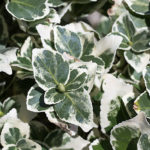Transplanting broadleaved evergreens

We enjoy seeing our broadleaved evergreens survive year after year in spite of being punished by our long, cold, icy Michigan winters, don’t we? Did you notice that I didn’t say snowy? It seems like we haven’t had much snow in the past few years, doesn't it? Whether it’s Rhododendron, Azalea, or Pieris, that fresh pop of color is a welcome sight each spring. Then you have your Hollies, Boxwood, Mahonia and some of the Euonymus. Euonyminians? Euonymi?

But even finicky broadleaved evergreens can outgrow an area that they’ve called home for many years. Which brings us to the title of the article:
Can you transplant broadleaved evergreens?
Yes. But a little extra care is needed to safely move them to their new home.
- Do not transplant them in the heat of summer. Early spring and late summer into early fall is optimal for survival, when top growth slows but root growth is still active. Any nurseryman will tell you that transplanting broadleafs in the middle of July when it’s 90° plus for weeks is a death sentence. They may live, sure, but we will never recommend you doing it. Wait until late August – early September if at all possible.

- These plants have very shallow, fibrous root systems. When digging, focus more on the width versus the depth. You’ll still need some depth, believe me, but I would recommend going as wide as the plant itself, and then add some more. Easily an extra third of the plant. Get some burlap to help support the root ball while you are transferring it.

- After transplanting, apply Ferti-lome Root Stimulator and Plant Starter Solution. This product can reduce transplant shock and is safer to use than conventional fertilizers. You may also use a slow release fertilizer such as the organic Tone series (Plant Tone, Flower Tone, or Holly Tone) to help the healing process. You do not want to use any strong quick-release fertilizers at this time.

- Water, water, WATER! Water daily for at least two weeks, and please, for longer than one minute. Hit the foliage (not in the heat of the day), and especially soak the ground. Remember, they have shallow roots, so this will be absorbed quickly. Using a quality bark mulch is also a good idea.

Remember to site your broadleaved evergreen plants where they will be protected from winter sun such as the north or east side of a building or under a canopy of trees. Smaller-leaved specimens like boxwood are more forgiving when it comes to winter burn but know that it is a possibility in some situations.
